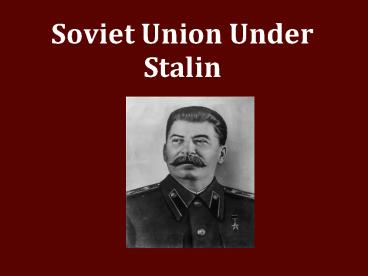Soviet Union Under Stalin - PowerPoint PPT Presentation
1 / 17
Title: Soviet Union Under Stalin
1
Soviet Union Under Stalin
2
Stalin's Five-Year Plan
- Stalin proposed the first of several "five-year
plans" in 1928. - It was aimed at building heavy industry,
improving transportation, and increasing farm
output. - Government now controlled all economic activity.
- This led the Soviet Union into a command economy.
3
Command Economy
- The Soviet Union developed a command economy
under Stalin. - In a command economy, government officials made
all basic economic decisions. - The government owned all businesses and
distributed all resources.
4
Collectivization in Agriculture
- Stalin also brought agriculture under
governmental control. - He wanted all peasants to farm on either state
owned farms or on collectives.
5
Collectivization in Agriculture
- The government wanted farmers to produce more
grain to feed workers in the city. - This also helped to sell grain abroad to earn
more money.
6
Collectives
- Collectives are large farms owned and operated
by peasants as a group. - Stalin thought that small farms run by peasants
were inefficient and a threat to state power. - Stalin wanted all peasants to farm on either
state-owned farms or collectives. - Government provided tractors, fertilizers, and
better seeds. Peasants learned modern farming
methods and they were allowed to keep their
houses and personal belongings.
7
Collectives
- Animals and implements were turned to a
collective. - The state set all of the prices and controlled
access to farm supplies. - Peasants were upset because they didn't want to
sell their crops at low prices. - They burned their crops, killed their animals and
destroyed their tools.
8
Kulaks
- Stalin believed that kulaks, or wealthy farmers,
were behind the resistance by burning their
crops, killing their animals and destroying their
tools. - In 1929, Stalin liquidated the kulaks as a class.
He did this by confiscating their land, sending
them to labor camps where thousands were killed
or died from being overworked. - This made the peasants angry, so they grew just
enough crops for themselves.
9
Kulaks
- In response, the government seized all the grain
to meet industrial goals leaving the peasants to
starve. - Between that policy and the poor harvest of 1932,
there was a bad famine named "Terror Famine". In
the Ukraine, five to eight million people died.
10
Gulags
- Stalin used terror as a weapon against his own
people by violating their rights, opening private
letters, planting listening devices, having no
free press, and no safe way of protesting.
11
Gulags
- Critics of Stalin were rounded up and sent to the
Gulag, a system of brutal labor camps, was
created in Siberia (north-central Soviet Union)
where many died.
12
The Great Purge
- Stalin and his secret police went after
Bolsheviks who were involved in the original 1917
Revolution. - The terror then targeted army heroes, industrial
managers, writers, and ordinary citizens. - They were charged with crimes ranging from
counterrevolutionary plots to failure to meet
production quotas.
13
The Great Purge
- 1937-1938, was mostly directed against Ukranians
. The secret police rounded up millions of people
and either sent them to Siberian prisons or the
executed them. The entire Central Committee and
Politburo of the Ukraine were killed.
Stanlin wanted to get rid of any potential
enemies from within the Communist Party. - "Trials" and executions were carried out by the
NKVD (secret police) who had pratically unlimited
power over innocent people's life and death.
14
Comintern
- Policy that encouraged world-wide communist
revolution. The Comitern's supported
revolutionary groups outside the Soviet Union and
used propaganda against capitalism. - It made Western powers highly suspicious of the
Soviet Union.
15
Socialist Realism
- Stalin required artists and writers to create
their works in a style that showed Soviet life in
a positive way and promoted hope in the communist
future. - Socialist Realism was thought of as following in
footsteps of the great Russian authors Tolstoy
and Chekhov.
16
Russification
- Stalins policy was to make the culture of all
Soviet Republics, Russian in nature. - The republics were forced to adopt the language
and traditions of Russia while ignoring their own.
17
Women
- Under the Communist party, women won equality
under the law and gained access to education and
a wide range of jobs. - By the late 1930, some Soviet women were employed
in medicine and engineering. - Others worked in factories in construction and on
collectives with in their families. They earned
the same low wages as men.































